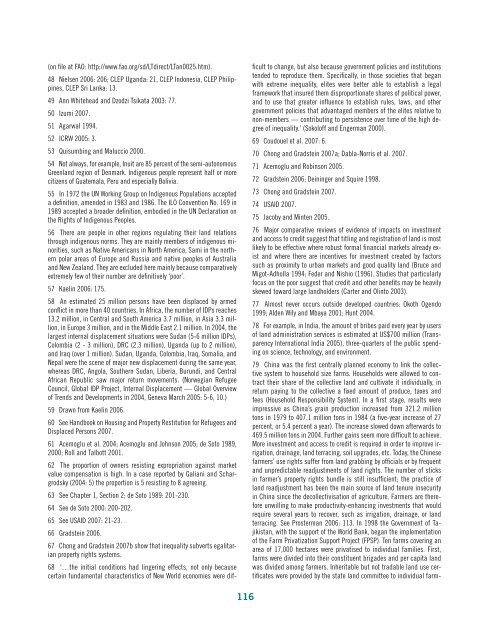Download the file - United Nations Rule of Law
Download the file - United Nations Rule of Law
Download the file - United Nations Rule of Law
You also want an ePaper? Increase the reach of your titles
YUMPU automatically turns print PDFs into web optimized ePapers that Google loves.
(on fi le at FAO: http://www.fao.org/sd/LTdirect/LTan0025.htm).48 Nielsen 2006: 206; CLEP Uganda: 21, CLEP Indonesia, CLEP Philippines,CLEP Sri Lanka: 13.49 Ann Whitehead and Dzodzi Tsikata 2003: 77.50 Izumi 2007.51 Agarwal 1994.52 ICRW 2005: 3.53 Quisumbing and Maluccio 2000.54 Not always, for example, Inuit are 85 percent <strong>of</strong> <strong>the</strong> semi-autonomousGreenland region <strong>of</strong> Denmark. Indigenous people represent half or morecitizens <strong>of</strong> Guatemala, Peru and especially Bolivia.55 In 1972 <strong>the</strong> UN Working Group on Indigenous Populations accepteda defi nition, amended in 1983 and 1986. The ILO Convention No. 169 in1989 accepted a broader defi nition, embodied in <strong>the</strong> UN Declaration on<strong>the</strong> Rights <strong>of</strong> Indigenous Peoples.56 There are people in o<strong>the</strong>r regions regulating <strong>the</strong>ir land relationsthrough indigenous norms. They are mainly members <strong>of</strong> indigenous minorities,such as Native Americans in North America, Sami in <strong>the</strong> nor<strong>the</strong>rnpolar areas <strong>of</strong> Europe and Russia and native peoples <strong>of</strong> Australiaand New Zealand. They are excluded here mainly because comparativelyextremely few <strong>of</strong> <strong>the</strong>ir number are defi nitively ‘poor’.57 Kaelin 2006: 175.58 An estimated 25 million persons have been displaced by armedconfl ict in more than 40 countries. In Africa, <strong>the</strong> number <strong>of</strong> IDPs reaches13.2 million, in Central and South America 3.7 million, in Asia 3.3 million,in Europe 3 million, and in <strong>the</strong> Middle East 2.1 million. In 2004, <strong>the</strong>largest internal displacement situations were Sudan (5-6 million IDPs),Colombia (2 - 3 million), DRC (2.3 million), Uganda (up to 2 million),and Iraq (over 1 million). Sudan, Uganda, Colombia, Iraq, Somalia, andNepal were <strong>the</strong> scene <strong>of</strong> major new displacement during <strong>the</strong> same year,whereas DRC, Angola, Sou<strong>the</strong>rn Sudan, Liberia, Burundi, and CentralAfrican Republic saw major return movements. (Norwegian RefugeeCouncil, Global IDP Project, Internal Displacement — Global Overview<strong>of</strong> Trends and Developments in 2004, Geneva March 2005: 5-6, 10.)59 Drawn from Kaelin 2006.60 See Handbook on Housing and Property Restitution for Refugees andDisplaced Persons 2007.61 Acemoglu et al. 2004; Acemoglu and Johnson 2005; de Soto 1989,2000; Roll and Talbott 2001.62 The proportion <strong>of</strong> owners resisting expropriation against marketvalue compensation is high. In a case reported by Galiani and Schargrodsky(2004: 5) <strong>the</strong> proportion is 5 resisting to 8 agreeing.63 See Chapter 1, Section 2; de Soto 1989: 201-230.64 See de Soto 2000: 200-202.65 See USAID 2007: 21-23.66 Gradstein 2006.67 Chong and Gradstein 2007b show that inequality subverts egalitarianproperty rights systems.68 ‘…<strong>the</strong> initial conditions had lingering effects, not only becausecertain fundamental characteristics <strong>of</strong> New World economies were difficult to change, but also because government policies and institutionstended to reproduce <strong>the</strong>m. Specifi cally, in those societies that beganwith extreme inequality, elites were better able to establish a legalframework that insured <strong>the</strong>m disproportionate shares <strong>of</strong> political power,and to use that greater infl uence to establish rules, laws, and o<strong>the</strong>rgovernment policies that advantaged members <strong>of</strong> <strong>the</strong> elites relative tonon-members — contributing to persistence over time <strong>of</strong> <strong>the</strong> high degree<strong>of</strong> inequality.’ (Sokol<strong>of</strong>f and Engerman 2000).69 Coudouel et al. 2007: 6.70 Chong and Gradstein 2007a; Dabla-Norris et al. 2007.71 Acemoglu and Robinson 2005.72 Gradstein 2006; Deininger and Squire 1998.73 Chong and Gradstein 2007.74 USAID 2007.75 Jacoby and Minten 2005.76 Major comparative reviews <strong>of</strong> evidence <strong>of</strong> impacts on investmentand access to credit suggest that titling and registration <strong>of</strong> land is mostlikely to be effective where robust formal fi nancial markets already existand where <strong>the</strong>re are incentives for investment created by factorssuch as proximity to urban markets and good quality land (Bruce andMigot-Adholla 1994; Feder and Nishio (1996). Studies that particularlyfocus on <strong>the</strong> poor suggest that credit and o<strong>the</strong>r benefi ts may be heavilyskewed toward large landholders (Carter and Olinto 2003).77 Almost never occurs outside developed countries: Okoth Ogendo1999; Alden Wily and Mbaya 2001; Hunt 2004.78 For example, in India, <strong>the</strong> amount <strong>of</strong> bribes paid every year by users<strong>of</strong> land administration services is estimated at US$700 million (TransparencyInternational India 2005), three-quarters <strong>of</strong> <strong>the</strong> public spendingon science, technology, and environment.79 China was <strong>the</strong> fi rst centrally planned economy to link <strong>the</strong> collectivesystem to household size farms. Households were allowed to contract<strong>the</strong>ir share <strong>of</strong> <strong>the</strong> collective land and cultivate it individually, inreturn paying to <strong>the</strong> collective a fi xed amount <strong>of</strong> produce, taxes andfees (Household Responsibility System). In a fi rst stage, results wereimpressive as China’s grain production increased from 321.2 milliontons in 1979 to 407.1 million tons in 1984 (a fi ve-year increase <strong>of</strong> 27percent, or 5.4 percent a year). The increase slowed down afterwards to469.5 million tons in 2004. Fur<strong>the</strong>r gains seem more diffi cult to achieve.More investment and access to credit is required in order to improve irrigation,drainage, land terracing, soil upgrades, etc. Today, <strong>the</strong> Chinesefarmers’ use rights suffer from land grabbing by <strong>of</strong>fi cials or by frequentand unpredictable readjustments <strong>of</strong> land rights. The number <strong>of</strong> sticksin farmer’s property rights bundle is still insuffi cient; <strong>the</strong> practice <strong>of</strong>land readjustment has been <strong>the</strong> main source <strong>of</strong> land tenure insecurityin China since <strong>the</strong> decollectivisation <strong>of</strong> agriculture. Farmers are <strong>the</strong>reforeunwilling to make productivity-enhancing investments that wouldrequire several years to recover, such as irrigation, drainage, or landterracing. See Prosterman 2006: 113. In 1998 <strong>the</strong> Government <strong>of</strong> Tajikistan,with <strong>the</strong> support <strong>of</strong> <strong>the</strong> World Bank, began <strong>the</strong> implementation<strong>of</strong> <strong>the</strong> Farm Privatization Support Project (FPSP). Ten farms covering anarea <strong>of</strong> 17,000 hectares were privatised to individual families. First,farms were divided into <strong>the</strong>ir constituent brigades and per capita landwas divided among farmers. Inheritable but not tradable land use certificates were provided by <strong>the</strong> state land committee to individual farm-116
















